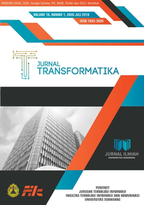SYSTEM MODEL FOR WEB-BASED TEACHER PERFORMANCE ASSESSMENT
DOI:
https://doi.org/10.26623/transformatika.v17i1.1413Keywords:
Teacher Performance, DSS, AHPAbstract
The performance of teachers in educational institutions needs to have an appreciation and assessment that has a basis. Teacher performance assessment is one of the bases for decision making related to the career of the teacher. To improve the quality and accuracy of performance appraisal, this study designs a web-based teacher performance assessment decision support system. The Decision Support System method used is Analytical Hierarchy Process (AHP), and information system design uses the Object Oriented Analysis and Design (OOAD) method. Respondents in this study were deputy principals, teacher representatives, and committee representatives. The results of the calculation of the respondent questionnaire were carried out with a paired comparison matrix. The results of the combined calculation showed that the first level criteria which were the highest weighted were Social with a weight of 33.4% and the alternative teacher with the best performance was Vera Asmara with a value of 22.9%.
References
Peraturan Pemerintah Republik Indonesia Nomor 19 Tahun 2017 Tentang Perubahan Atas Peraturan Pemerintah Nomor 74 Tahun 2008 Tentang Guru.
Undang-Undang Republik Indonesia Nomor 14 Tahun 2005 Tentang Guru Dan Dosen
Penilaian Kinerja Guru, Direktorat Tenaga Kependidikan Direktorat Jenderal Peningkatan Mutu Pendidik Dan Tenaga Kependidikan Departemen Pendidikan Nasional 2008
A. Paramita, F. A. Mustika, N. Farkhatin, Aplikasi Sistem Pendukung Keputusan Guru Terbaik Berdasarkan Kinerja dengan Metode Analytical Hierarchy Process (AHP) , TEKNOSI, Vol. 03, No. 01, pp. 9 18, April 2017
T. Mufizar, Susanto, N. Nurjayanti, Sistem Pendukung Keputusan Penilaian Kinerja Guru di SDN Mohammad Toha menggunakan Analytical Hierarchy Process (AHP) , in Konferensi Nasional Sistem & Informatika 2015, pp. 581 - 586
Sopiah, E. K. Putra, A. I. Hadiana, Sistem Pendukung Keputusan Rekomendasi Guru Tetap Berdasarkan Data Guru Honorer Berprestasi Menggunakan Metode Analytic Hierarchy Process (AHP) dan Simple Additive Weighting (SAW) , in Seminar Nasional Teknologi Informasi dan Multimedia 2017, pp.79 84
Fahrizal, Sistem Pendukung Keputusan Penilaian Kinerja Guru Berdasarkan Hasil Evaluasi Umpan Balik Dari Beban Kerja Menggunakan Metode Analytical Hierarchy Process (AHP) (Studi Kasus : SD LPI At-Taufiq) , JURNAL LENTERA ICT Vol.3 No.1, pp. 19 27, Mei 2016
O. S. Vaidya, S. Kumar, Analytic hierarchy process: An overview of applications , European Journal of Operational Research 169, pp.1 29, 2006
Thomas L=-. Saaty, How to make a decision: The Analytic Hierarchy Process , European Journal of Operational Research 48, pp 9-26, 1990
Thomas L. Saaty, Luis G. Vargas, Models, Methods, Concepts & Applications of the Analytic Hierarchy Process Second Edition, International Series in Operations Research & Management Science Volume 175, Springer New York Heidelberg Dordrecht London, 2012
Thomas L. Saaty, Some Mathematical Concepts Of The Analytic Hierarchy Process Behaviormetrika No.29, pp. 1-9, 1991
Thomas L. Saaty, Decision Making with the Analytic Hierarchy Process , Int. J. Services Sciences, Vol. 1, No. 1, pp. 83 98, 2008.
Ernest Forman, Kirti Peniwati, Aggregating individual judgments and priorities with the Analytic Hierarchy Process , European Journal Of Operational Research
Thomas L. Saaty € Mujgan Sa˘gır –zdemir, How Many Judges Should There Be in a Group ? , © Springer-Verlag Berlin Heidelberg 2015.
Downloads
Published
Issue
Section
License
Authors who publish with this journal agree to the following terms:
- Authors retain copyright and grant the journal right of first publication with the work simultaneously licensed under a Creative Commons Attribution License that allows others to share the work with an acknowledgement of the work's authorship and initial publication in this journal.
- Authors are able to enter into separate, additional contractual arrangements for the non-exclusive distribution of the journal's published version of the work (e.g., post it to an institutional repository or publish it in a book), with an acknowledgement of its initial publication in this journal.
- Authors are permitted and encouraged to post their work online (e.g., in institutional repositories or on their website) prior to and during the submission process, as it can lead to productive exchanges, as well as earlier and greater citation of published work.

Transformatika is licensed under a Creative Commons Attribution 4.0 International License.


